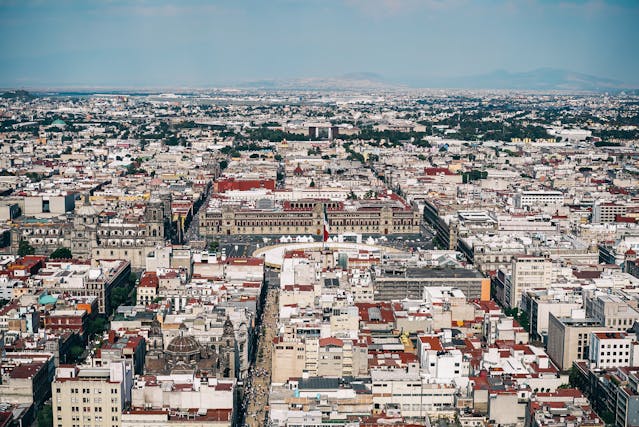
Why is Mexico City sinking? Mexico City is sinking because they are pumping more water out of the underground aquifer than can be replaced.
Mexico City is the capital of Mexico, and it has a population of almost 22 million people, which is over 17% of the population of Mexico. Since the beginning of the 20th century, the city has started to sink, and it sinks an average of 50 cm per year. Some parts of the city have sunk over 9 meters. To find out why, we need to start with the Aztecs.
The Aztec Empire was spread over many city states and the largest of them was founded where Mexico City is today. It was called Mexico-Tenochtitlan and it was founded in 1325. The city was built on an island in the middle of Lake Texcoco and the Aztecs created a system of dykes to control the lake and prevent flooding. The population of the city was probably 400,000 people at its peak and they travelled to and from the city by canoe and via a causeway to the mainland. When the Spanish arrived, they set their sites on conquering all of the Aztec cities and Mexico-Tenochtitlan fell in August 1521. The Spanish had besieged the city for three months and that, plus the smallpox they brought with them from Spain, decimated the city’s population. The Spaniards decided to rebuild the city as the capital of their Spanish colony in South America.
Mexico City was rebuilt on the same island in Lake Texcoco as the Aztec city had been, and its population started to grow. By the early 1600s, it had grown so much that the city needed to expand. The space on the island was obviously limited and the ideal solution would have been to relocate the city before it reached the point where it needed to be expanded. Failing that, the city could have been built on existing islands or on the shores around the lake, keeping the lake as it was. The Spaniards decided that the best option was to drain the lake so that they could build on its bed. They built channels and tunnels to divert the lake’s water into the Panuco River and Lake Texcoco began to dry up. The Spaniards hoped that drying up the lake would make more agricultural land available and give them a lot more land to build the city on. This was rather shortsighted. After the Lake had been drained and the city expanded, the Spaniards realized that when there was heavy rainfall, such as in 1629 and 1630, the dried-up lake flooded, which flooded the city and caused tremendous damage. This has been an ongoing problem since then. Today, almost the entire lake has gone, and Mexico City stretches all across the lakebed.
The city was probably sinking from the early days, but it was less noticeable because there were fewer buildings. Since the beginning of the 20th century the sink has sped up and become noticeable. There are two reasons why it is sinking. The first is that the lakebed is made of soft clay. The second reason is that the water table underneath the lakebed is being drained and the ground is sinking into the space.
When Mexico City was built across Lake Texcoco, the did free up more land, but they also removed the closest water source. The Aztecs had used the water from the lake for everything, but the Spaniards had to look elsewhere for their water. Over the years they developed two systems for bringing water into the city. The first is a series of pipes that brings water from reservoirs over 120 km away. This is very expensive, and it furnishes about 30% of the city’s water. The other 70% is brought up from the aquifers that are underneath the city. The trouble is the aquifers are drying up and Mexico City is running out of water. It is already a huge problem and many parts of the city don’t have enough water. It is worsened because Mexico City doesn’t treat any of its own wastewater, but pumps it to another city down in the valley. This means there is a constant water deficit. And, as the aquifer dries up, it creates space, which the city is sinking into. Mexico City also has the problem that a lot of companies, like Coca Cola, are located there and they are contractually allowed the water that they need, taking it away from regular people.
The sinking city is being caused by the water being taken out of the aquifers, but the sinking city is itself causing a water problem. As the city sinks, the water pipes get twisted and break. It is estimated that 40% of the city’s water is lost from leaks in the pipes. Mexico City doesn’t have the ability to fix all the leaks. There is a lot of rain every year, but there is no system to collect the rainwater and it causes some of the flashfloods that have plagued Mexico City since it was first built.
The only way to fix it is to create waste treatment plants, fix all the pipes, make a system of catching rainwater, and force the large corporations to move. That might be more than politicians are willing to do, though. And this is what I learned today.
Photo by Ricky Esquivel: https://www.pexels.com/photo/aerial-photography-of-city-1720086/
Sources
https://www.britannica.com/place/Lake-Texcoco
https://blogs.loc.gov/law/2022/09/mexico-citys-desage-of-1607-from-an-island-to-a-water-crisis
https://en.wikipedia.org/wiki/Mexico_City
https://en.wikipedia.org/wiki/Valley_of_Mexico
